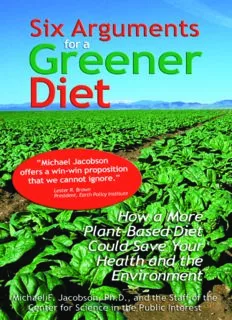
Six Arguments for a Greener Diet PDF
Preview Six Arguments for a Greener Diet
Six Arguments for a Greener Diet Six Arguments for a Greener Diet How a More Plant-Based Diet Could Save Your Health and the Environment Center for Science in the Public Interest Copyright © 2006 by Center for Science in the Public Interest First Printing, July 2006 2 4 6 8 10 9 7 5 3 1 The Center for Science in the Public Interest (CSPI), founded in 1971, is a nonprofit organization that conducts innovative education, research, and advocacy programs in the area of nutrition, food safety, environment, and alcoholic beverages. CSPI is supported by the 900,000 subscribers in the United States and Canada to its Nutrition Action Healthletter and by foundation grants. Center for Science in the Public Interest 1875 Connecticut Avenue, NW, #300 Washington, DC 20009 Tel: 202-332-9110; fax: 202-265-4954 Email: [email protected]; Internet: www.cspinet.org ISBN 0-89329-049-1 Visit CSPI’s Eating Green web site: www.EatingGreen.org. The Web of Animal-Based Foods and Problems Natural gas, ores Fertilizer Pesticides Air, soil & water Risks to pollution farmers & wildlife Irrigation water Ground- water Antibiotics, depletion hormones Animal feed Soil erosion Health & ecological risks Global Animal warming cruelty (methane) Meat, Manure dairy, eggs Soil Air Water Food Cancer Heart pollution pollution pollution poisoning disease Eating Green: By the Numbers (All figures apply to the United States, except where noted, and are approximate. See text for sources.) Health 3 years: how much longer vegetarian Seventh-day Adventists live than non- vegetarian Seventh-day Adventists 4.9 servings: the servings of fruits and vegetables consumed daily, compared to the recommended 5 to 10 16 percent: the decreased mortality from heart disease associated with eating one additional serving of fruits or vegetables each day 24 percent: how much lower the rate of fatal heart attacks is in vegetarians com- pared to non-vegetarians 25 percent: the proportion of food-poisoning deaths due to pathogens from ani- mals or their manure 33 percent: the decrease in beef consumption since 1976 50 percent: how much less dietary fiber Americans consume than is recommended 51 percent: the reduction in risk of heart attack for people eating nuts five or more times per week compared to less than once a week 90 percent: the proportion of chickens contaminated with Campylobacter bacteria 100 percent: how much fattier meat is from a typical steer that’s fed grain rather than grass 199 pounds: the combined amount of meat, poultry, and seafood produced per American (2003) 1,100: the mortalities due each year to foodborne illnesses linked to meat, poul- try, dairy, and egg products 46,000: the number of illnesses due annually to antibiotic-resistant strains of Sal- monella and Campylobacter 63,000: the number of deaths from coronary heart disease caused annually by the fat and cholesterol in meat, dairy, poultry, and eggs $7 billion: the annual medical and related costs of foodborne illnesses $37 billion: the annual cost of drugs to treat high blood pressure, heart disease, and diabetes $50 billion: the annual cost of coronary bypass operations and angioplasties Environment 1 pound: the amount of fertilizer needed to produce 3 pounds of cooked beef 5 times as much: the irrigation water used to grow feed grains compared to fruits and vegetables 5 tons: the soil lost annually to erosion on an average acre of cropland 7 pounds: the amount of corn needed to add 1 pound of weight to feedlot cattle (some of that weight gain is not edible meat) 19 percent: the proportion of all methane, a greenhouse gas, emitted by cattle and other livestock 41 percent: the share of irrigated land planted in livestock feed crops 66 percent: the proportion of grain that ends up as livestock feed at home or abroad 331: the number of odor-causing chemicals in hog manure 4,500 gallons: the rain and irrigation water needed to produce a quarter-pound of raw beef 8,500 square miles: the size of the “dead zone” created in the Gulf of Mexico by fertilizer runoff carried by the Mississippi from the upper Midwest 33 million: the number of cars needed to produce the same level of global warm- ing as is caused by the methane gas emitted by livestock and their manure 22 billion pounds: the amount of fertilizer used annually to grow feed grains for American livestock 3.3 trillion pounds: the amount of livestock manure produced annually 17 trillion gallons: the amount of irrigation water used annually to produce feed for U.S. livestock Animal Welfare 0.5 square feet: the amount of space allotted to the average layer hen 30: the number of chickens and turkeys consumed annually by the average American 13,200: the number of chickens killed each hour in a modern slaughterhouse 50,000: the number of broiler chickens in the largest growing sheds 140 million: the number of cattle, pigs, and sheep slaughtered each year Contents Acknowledgments iii Abbreviations v Preface: Greener Diets for a Healthier World vii The Context The Fatted Steer 3 The Arguments #1. Less Chronic Disease and Better Overall Health 17 #2. Less Foodborne Illness 59 #3. Better Soil 73 #4. More and Cleaner Water 87 #5. Cleaner Air 103 #6. Less Animal Suffering 113 Making Change Changing Your Own Diet 143 Changing Government Policies 151 i
Description: